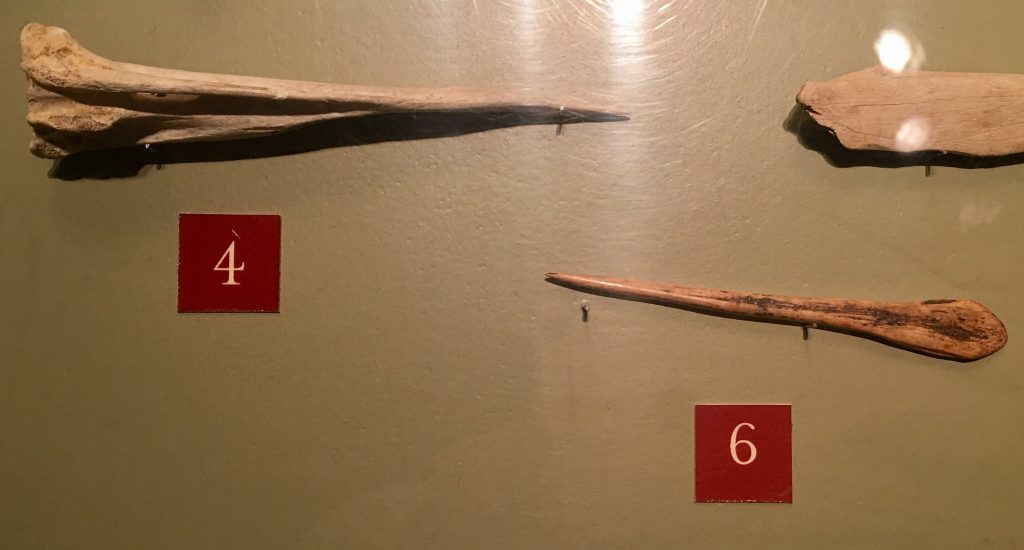

Awls Made From Turkey and Deer Bones, and Bone Needle, North Carolina Museum of History. Personal photograph by author. October 2, 2018.
These turkey and deer bone awls from 1650-1670 were primarily used to pierce holes in animal hides for clothing and other decorative items. Found in lower Sauratown in North Carolina, they provide insight into how animals were valuable, multi-purpose resources centuries ago. Saura Indians, also known as the Cheraw, inhabited Sauratown during this time period and “were one of a number of small Siouan tribes in the colonial backcountry (the modern-day Piedmont) of North Carolina” (Butler 2006, par. 1). Hernando de Soto was one of the first known Spanish colonialists to mention the Saura Indians in a journal of his exploration dating back to 1540 (Butler 2006, par. 1).
Although the awls were primarily employed for sewing clothing and decorative objects, they could also be useful for constructing containers to store food. As farmers and seasonal hunters, the Saura would need to store food when it was plentiful to assure a supply over the entire year (Barkley 1992, par. 9). Containers of hide, possibly from the deer that provided the bone for the awl, may have been useful for this purpose. Perchance, the Saura created something similar to the parfleche, a hide sack used to store food, created by the Plains Indians of North America in later periods (Gaur, Rikkanen, Mahajan2018, par.1). The animal origin of these awls provides a view of the game hunted by Saura Indians in this geographical region.
Both the animals used for the awls and the non-wasteful practices of the Saura Indians help to create better understanding and trace the history of the food consumption and practices in modern Chapel Hill. The food sustainability movements of Chapel Hill today could be seen as an echo of the Saura Indian’s economical food utilization practices. Thus, the consumption of turkey and deer in modern Chapel Hill is shown to have roots hundreds of years old, back to the Saura Indians, and linking the past to the present through food.
Elizabeth Sigarto
Works Cited
Awls Made From Turkey and Deer Bones, and Bone Needle, North Carolina Museum of History. Personal photograph by author. October 2, 2018.
Barkley, Meredith. “The Saura Indians Met a Silent End.” Greensboro News and Record. June 24, 1992. Accessed October 08, 2018. https://www.greensboro.com/the-saura-indians-met-a-silent-end/article_578cb1ad-99e4-5446-8c5e-9935d1185c97.html.
Butler, Lindley S. “Saura Indians.” Weapons in the War of 1812 | NCpedia. 2006. Accessed October 08, 2018. https://www.ncpedia.org/saura-indians.
Gaur, Aakanksha, Rikkanen, Amy, Deepti, Mahajan. “Parfleche American Indian Art.” Encyclopædia Britannica. January 19, 2018. Accessed October 08, 2018. https://www.britannica.com/art/parfleche.